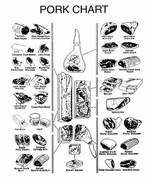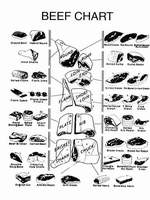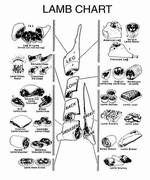



www.britishbarbecue.co.uk
Buying The Right Brisket
You will find two types of brisket at the butcher shop. Trimmed and Untrimmed. From the viewpoint of slow smoking, use the untrimmed brisket. During the 4 to 12 hours of cooking, the fat, when placed on top, will drip over the meat and help keep it moist. This will retain the juices and flavour of the meat. When completed, the fat can be trimmed off. For purposes of serving it is good to know that a brisket will weigh-in after cooking at about 50% of the uncooked weight. Remember this at the time of purchase and don't go hungry!
Country Style Ribs
Country Style Ribs are not ribs at all, they are from the bone-in loin and come from the end of the loin closest to the shoulder of a pig. The meat is very lean, more so than from the spare rib. There is, however bone and fat portions present. Baby Back Ribs (Loin Ribs) More expensive than spare ribs and ironically less meat. They average from 650g to 1kg each. The flavour is excellent and the smaller ones are great for grilling. Again, do not over cook!
Beef Steaks
steak continues to be one of the western worlds favourite foods.
The less you do to a steak, the better it will taste. Spend your time selecting, trimming and preparing the meat rather than adding things to it. Get a good piece of meat and Don't mess it about by adding sauces etc. to it.
Beef, is graded according the amount of fat interspersed within the muscle tissue. Called "marbling" it appears like the white spots and streaks in marble, the more of this marbling, the better the meat.
Only certain parts of the carcass are suitable for grilling. A 420kg. Beef will yield only about 32kg of meat suitable for grilling. Only the little used, large muscles are tender enough for grilling.
Most tender, and with least flavour, is the tenderloin or filet from which come the Filet mignon and Chateaubriand. This cut has little natural fat.
The ribeye, or rib steak, are tender and has more flavour.
The T-bone has a "T" shaped bone hence the name, it has less of the tenderloin, on one side of the bone, and a longer T than the Porterhouse.
When the tenderloin side of a Porterhouse is removed the remainder becomes a Club steak.
When meat remaining on the other side of the T is deboned it become a shell steak, or a strip steak.
Sirloin steaks are larger ,they are tender and very tasty.
Sirloin tip steaks are boneless, less tender but very tasty.
All of the above cuts are tender and delicious, do not cut them less than 25mm thick. It is better to grill one large, thick steak and carve it after cooking than to cut it up before grilling it.
Selecting a Beef Steak
The meat should be a consistent bright but light red colour. The white marbling should be distributed through the meat and the flecks and lines should be small and fine.
The meat should be a fine grained not coarse or variable. Steaks that are already cut should already be trimmed except for about 6mm of fat. The fat should be creamy in colour, not grey or yellow. The meat should be moist, but not wet.
Quantities
For adults with normal appetites, allow 280-340g (10-12 oz) for each steak and do not cut it less then 25mm thick, a thick stake holds in the juices and cooks better. Remember British is now the safest beef in the world.
Types and Cuts of meat for Sausage making
In older times, any thing that wasn't for a specific purpose went into sausage. For pork, you had your hams, chops, ribs and roasts, You had your bacon, but what about all the other parts of meat that were left over?
For Beef, you have roasts, steaks, briskets, ribs, and hamburger. Meat loaf gets old and so does those fried/grilled burgers, so what to do with it that'll be most tasty?
mince (grind) it, Spice it, stuff it, then cook and enjoy. There are some cuts of meat that make for nice sausages without the hassle of trying to find lean meat then fat for it.
Cuts that take the guess work from fat to lean rations
Pork - Boston Butts or Pork shoulder. These are approximately 75% lean to 25% fat which is perfect for almost any type of fresh sausage. You can purchase these boneless or bone in... Bone in is cheaper, just be sure to weigh the actual meat for proper amounts before starting the process.
Beef - Chuck Roast, 7 bone roast, Blade cut roast, pot roast or any cuts form the shoulder or chuck works just great as is with the correct % of lean to fat.
Veal - Any cut of veal is good to use, especially if you are going to make Bratwurst. But unfortunately, it's too damn expensive unless you have access to some home butchered.
Fat
In the course of a normal day/diet, if you were to separate out the fat from all the products that you eat, the average person consumes 8 tablespoons of fat. Can you imagine sitting down to the table and eating that with a spoon? Well, not to get to carried away, fat is necessary for good health. Certain vitamins are carried through the body while it is processing fat. It is beyond the scope of this site to teach the benefits of saturated and/or unsaturated fats, I just wanted you to know that while sausages are somewhat fatty, they can fit into a normal diet and be enjoyed.
Fat is necessary in sausage to give it the textures and flavour that we know and love. I know that when you take an extremely lean cut of meat and salt/pepper it then cook it, not only does it taste like leather, it has the same texture. So fat, taken in properly, is not only needed for good health, it is necessary for flavour.
This WWW Site is constructed, maintained and copyrighted by: Oscar Enterprises UK. ALL RIGHTS RESERVED
For Information on Advertising Please contact sales@britishbarbecue.co.uk